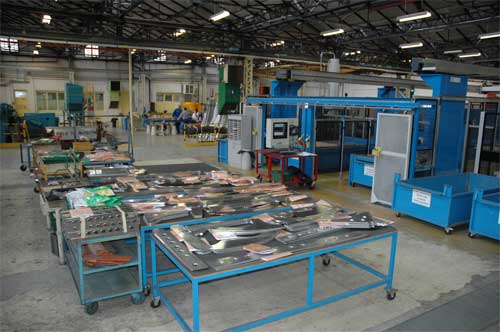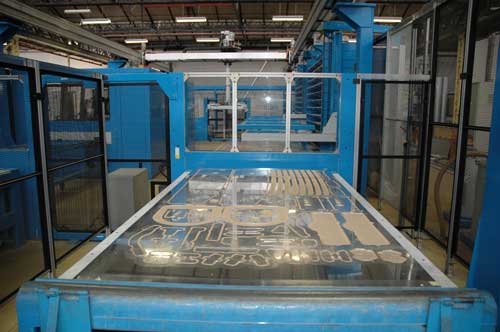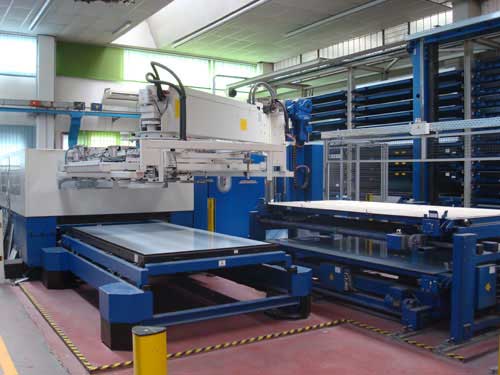Intelligent nesting software for routing Socata’s aluminium parts

When modernizing the routing cell of its Tarbes plant, the aeronautics manufacturer Socata installed beginning of 2008 an entirely automated machine based on the ‘detagging’ routing technology. Completely integrated to Socata’s information system, Alma’s software feeds the machine with nestings on a daily basis, automatically optimizing the material yield while limiting machining times.
Socata is one of the leading manufacturers in the field of general aviation with over 17,000 planes built since the creation of the company in 1911, at the time Morane-Saulnier. Its current production includes the TBM 850 high-speed jet prop engines and aero structures with a fairing specialty for civil and military transportation planes, business jets and helicopter cells. Headquartered in Tarbes (Hautes-Pyrénées, France) with a North-American base in Florida, Socata employs 1,800 persons and generates a turnover of 280 million EUR. Previously integrated in the EADS Group, Socata is currently controlled by the Daher equipment manufacturer. The new Daher – Socata entity is now a first-rank equipment manufacturer able to answer the aeronautics programs of the future.
Modernizing and automating the routing cell
In 2005, Socata started thinking of replacing its routing means (two CMS machines and a first-generation Sapex programming system with manual nesting used on two 2 X 8 shifts work stations) technologically outdated. The new system had to allow the routing of all aluminum alloys and operate with all customer programs, which represents around 1.2 million parts routed every year, or over 80 tons of aluminum.
“In our plant, the routing cell is the cornerstone of the metal-sheet-working flow. It represents the interface between the arrival of the material just-in-time and the provision of blanks for forming”, explains Jean-Christophe Michel, Project Manager in the Basic-Part Unit Preparation Department.“This unique means is essential to our development”, he adds. “We therefore needed to invest in a flexible and modular system that would provide Socata with a basic-part production capacity at a reasonable cost”.
A first benchmarking led to the launching of a call for tenders concerning two new routing machines. But the project has to be reviewed as the gains in productivity were too low with regard to the current system. The new study showed that enhanced gains in productivity implied automating the peripheral tasks and the nesting system upstream.
Moreover, the new high-speed routing machine had to be able to produce in sheet-by-sheet mode but also in stacked-sheet mode. Indeed, with regard to the different customer programs, the size of Socata’s routed parts is very variable, from a few centimeters to a whole sheet-metal format. The installation of a routing system had thus to be multi-purpose and allow the machining of small and whole formats, from one to ten stacked sheets up to a 10-mm thickness.


A special machine based on the ‘detagging’ routing technology
Among the three possible solutions, Socata chose Cinetic Machining’s machine offer and Alma’s software offer. The machine proposed by Cinetic Machining, designer and rebuilder of machine tools specific to high-speed machining, was more adapted to Socata’s needs as it integrated all logistics and handling means together with the management of all peripheral elements (chip evacuation, tool management, user and IT interface for the follow-up of machine performance).
In terms of routing technology, Socata chose the intelligent ‘detagging’ solution in which bridge placement (material zone thanks to which the part remains attached to the skeleton) is auto-adaptive: the bridge number and position varies according to the geometry of parts in order to obtain maximum material yield. The machining strategy linked to this particular technology allows the optimization of paths and the finalization of parts in real time.
The machine is able to process a thickness range from 0.3 to 5 mm on formats of minimum 125 x 125 mm to maximum 2,500 x 1,250 mm. The system that maintains the stacked sheets, consisting of an alignment of straps placed on one side only, offers extra space for part nesting. The machine is able to execute the loading and unloading of 30 stacked sheets in concurrent operation time. The machining means integrates a system of pendular tables that minimizes spindle down-time.
The automatic nesting performance, proven during the tests previously carried out on Socata parts, was much superior to the other competitors’ offers.
Open, adaptable and automated programming software
The software had to answer several objectives to optimize data flows and costs, and be integrated to Socata’s production environment:
- to offer an interface with the production management system (SAP), notably to import the information necessary to the creation of manufacturing orders and the implementation of nestings;
- to create optimal nestings by finding a compromise between sheet stacking and sheet-by-sheet machining, and by cutting sheet offcuts according to a 125 x 125 mm step;
- to enable operators to focalize on decision making;
- to feed the data back to the control system and different information bases (tools, indicators, quality…).
The Alma solution based on the act/cut routing version software was thought to be the best to reach these objectives. The adaptability of the software and Alma’s capacity to meet the specific needs of customers were the strong points. The automatic nesting performance, proven during the tests previously carried out on Socata parts, was much superior to the other competitors’ offers. Alma’s knowledge of Socata’s production and parts background guaranteed a real continuity in the project follow-up.
The installation of the machine and software started in June 2007 and the new routing means was launched in March 2008.


Optimizing material yield and machining times thanks to automatic nesting
The first step when programming with act/cut consists of recovering and preparing the 2D geometries of parts originating from different CAD systems (Cadds 5, Catia V4, Catia V5). Three Drafter module licenses are dedicated to these operations that import DXF or IGES files, ‘clean’ the corresponding geometries and automatically assign the tools to them (taps and drills). Over 23,000 basic parts are thus managed in a library, among which 19,000 have been recovered from the previous CAM software thanks to a processing macro in concurrent operation time specifically developed by Alma.
After the processing of the geometry files, nesting is the key step in programming. From the daily needs transmitted every day to act/cut by SAP, the software automatically nests the parts to be produced, sorted out beforehand by material and thickness combination. The software respects the fiber direction if the information is transmitted by CAD, otherwise it can orientate the parts by increment of 1° between 0 and 180°. The objective is to optimize the global material yield of the launching (master file) and the routing time, this time being directly related to the number of sheets stacked for each nesting, within the maximum limit of a 10-mm stacking thickness. Taking into account these constraints, act/cut calculates three nesting proposals and for each of them, transmits information that will enable the user to choose the most interesting one. “The user’s decision always represents a compromise between reducing the offcut rate and minimizing the machining time”, explains Christian Ricaud, one of the software users. “In case of very high production for example, we tend to focus on machining time, that is to say maximal stacking of sheets”.
After having visualized all automatic nestings decided by the software, the user can intervene if he thinks it is necessary, for example to modify the orientation of large parts and relaunch automatic nesting to finalize nesting optimization. It is also possible to intervene upstream on the SAP imports to manage urgencies, modify the launching of stacked sheets or split them.
Another constraint imposed on the software: to optimize nesting by taking into account the 125-mm X or Y step. Indeed, if 95% of the sheet formats are standard (2,500 x 1,250 mm), it is possible to order smaller formats (whose length or width is a multiple of 125 mm) to reduce material costs. As Socata does not manage material stocks, the nesting results are used to determine the sheet quantities and formats to be ordered from the provider. The sheets are thus provided on demand so that parts can be cut 3 days after the day of nesting validation.
In addition to this information feedback to SAP concerning sheet formats and nested manufacturing orders, the nesting validation triggers the transmission of different act/cut data to the IT system of the machine, for post-processor execution (generation of the ISO program) and feeding of the ‘indicators’ bases (material offcuts, tools used, valorization of consumables) and ‘tools’ bases (list of tools to be assembled and machining length to be executed).
Automatic nesting has enabled the company to divide its preparation times by two and increase material yield by 23%.
Gains in productivity and more autonomous users
Eight months after the finalization of the installation, the new routing means and the act/cut software are already generating profits.
If we compare the Cinetic Machining machine to both previous machines, speed has increased by 25% within the same work time (3 x 8). Additional gains in productivity are still expected with the increase of the milling speed that is currently being tested in correlation with quality routing and tool wear.
Automatic nesting has enabled the company to divide its preparation times by two and increase material yield by 23% (the average offcut rate has decreased from 65 to 50%). According to the current cost of aluminum, this represents an economy of around 165 K€ on an annual basis. Optimized nesting has also reduced the number of sheets used by about 30%, which represents additional gains in terms of handling costs.
In accordance to Socata’s initial wishes, the act/cut software is much easier to use than the former system. Freed from time-consuming tasks thanks to the automated functions of the software, users can now really focus on decisions. As Jean-Christophe Michel sums up, “Operators should make decisions, not just press buttons; with the new system, our role is more central and logical”. The system is easy to use, which enables the users to redefine certain preparation and programming tasks: the programmers’ responsibility scope, currently the preparation of manufacturing ranges, will now include part-drawing management and nesting supervision.
Thanks to Alma’s experience in the setting-up of specific installations automated and integrated to a complex information system, Socata has managed its project in the given time. The excellent coordination with Cinetic Machining was also essential. Alma’s support, present at all stages of the project, from recovering the part database to implementing the different nesting strategies, was very much appreciated by Socata’s managers and users. Algorithmic techniques of optimization and spirit of partnership work together for the best!
©2009 Alma

